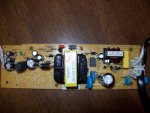- Joined
- Sep 7, 2007
- Messages
- 634
- Points
- 0
I just tore apart an APEX DVD player. Just to play around. I noticed the power supply in it could be useful. It has 12 volts, 5 volts, and 3.3 volts. Unfortunately I can't measure the current because I have no meter. But I did do this. I hooked up a cheap 5 mW laser pointer from Wal-Mart to it. I figure the duty cycle on those things are pretty much forever. Well anyways I left it on for roughly 2 minutes. My point is if these little tiny cheap 5mW laser diodes can handle that 3.3 volts(at whatever current), then a DVD burner LD should sure as heck withstand it. I will post pics as soon as I get my digital camera back. So the intent of this post was to inform people that an APEX DVD player for only $29 has a nice power supply in it.







